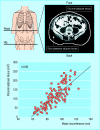Treatment of obesity: need to focus on high risk abdominally obese patients
- PMID: 11264213
- PMCID: PMC1119905
- DOI: 10.1136/bmj.322.7288.716
Treatment of obesity: need to focus on high risk abdominally obese patients
Figures





Comment in
-
Abdominal obesity and the "hypertriglyceridaemic waist" phenotype.BMJ. 2001 Mar 24;322(7288):687-9. doi: 10.1136/bmj.322.7288.687. BMJ. 2001. PMID: 11264193 Free PMC article. No abstract available.
References
-
- Bray GA, Bouchard C, James WPT, editors. Handbook of obesity. New York: Marcel Dekker; 1998.
-
- National Heart, Lung, and Blood Institute/National Institutes of Diabetes and Digestive and Kidney Diseases. Clinical guidelines on the identification, evaluation and treatment of overweight and obesity in adults. The evidence report. Bethesda: National Institutes of Health; 1998. pp. 1–228.
-
- WHO Consultation on Obesity. Preventing and managing the global epidemic. Geneva: World Health Organization; 1997. pp. 1–276. - PubMed
-
- Keys A, Fidanza F, Karvonen MJ, Kimura N, Taylor HL. Indices of relative weight and obesity. J Chronic Dis. 1972;25:329–343. - PubMed
-
- Vague J. La différenciation sexuelle, facteur déterminant des formes de l'obésité. Presse Med. 1947;30:339–340. - PubMed
Publication types
MeSH terms
LinkOut - more resources
Full Text Sources
Medical
